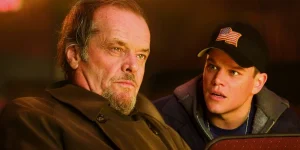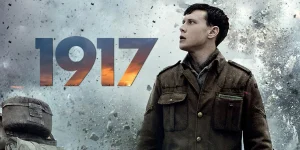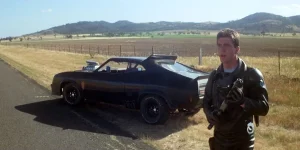The Road to Perdition is a somber and visually poetic crime drama directed by Sam Mendes, based on the graphic novel by Max Allan Collins and illustrated by Richard Piers Rayner. Set during the Great Depression, it’s a powerful story of fathers and sons, loyalty, vengeance, and the inescapable weight of violence. With stunning cinematography by Conrad L. Hall (his final work before his death), and a haunting score by Thomas Newman, this film blends gangster noir with emotional depth.
Table of Contents
ToggleDetailed Summary
Prologue: A Son’s Reflection
The film opens with a narration from young Michael Sullivan Jr., recalling a particular winter in 1931 when everything changed. He hints at his father’s enigmatic nature and the dark path that shaped their relationship. This sets the tone for a tale of legacy, morality, and redemption.
The Sullivans and the Rooney Crime Family
Michael Sullivan (played by Tom Hanks) is an enforcer for Irish mob boss John Rooney (Paul Newman), a man who considers Sullivan like a son. Rooney’s actual son, Connor Rooney (Daniel Craig), is volatile and impulsive, often endangering the family business with his reckless behavior. Sullivan is a quiet, deadly figure—a family man with a hidden, violent profession.
The Incident: A Witness to Murder
The plot shifts when Sullivan’s son, Michael Jr., secretly stows away in his father’s car and witnesses a mob hit carried out by his father and Connor. Though the child sees nothing specific, Connor becomes paranoid and decides to “clean house,” killing Sullivan’s wife and youngest son in a botched attempt to silence the family.
This act turns Sullivan against the Rooneys and begins his quest for vengeance—and protection—for himself and his surviving son.
On the Run and On a Mission
Sullivan and Michael Jr. flee, with Sullivan targeting the criminal organization’s money-laundering operations to cripple Rooney’s empire. Along the way, their bond deepens, with Sullivan teaching his son life skills, such as driving and money-handling, while attempting to shield him from the violence.
They are pursued by Harlen Maguire (played chillingly by Jude Law), a macabre crime scene photographer who moonlights as a hitman. Maguire adds tension and menace throughout their journey, as he doggedly follows them from city to city.
The Father-Son Dynamic
At its heart, The Road to Perdition is about the evolving relationship between father and son. Sullivan is a man torn between his role as a killer and his desire to give his son a better life—one without blood on his hands. Michael Jr., meanwhile, begins to understand his father’s complexity, seeing both the love and violence that define him.
Final Confrontation with John Rooney
Sullivan ultimately confronts John Rooney in a powerful and emotional scene. Rooney, who loved Sullivan like a son, accepts his fate. In a hauntingly silent execution sequence (only rain and the sound of a gun are heard), Sullivan kills Rooney and his guards—but leaves Connor alive for last.
Sullivan tracks Connor to a hotel in Chicago and kills him, finally avenging his wife and child. However, the story isn’t over yet.
⇢ VIRAL RIGHT NOW
Movie Ending
The final act takes place at a beach house in Perdition, a symbolic name representing both refuge and damnation. Sullivan and his son finally find peace—briefly.
As they settle in, Harlen Maguire ambushes Sullivan, shooting him twice. In a harrowing moment, just as Maguire is about to kill young Michael Jr., the boy hesitates with a gun—torn between fear and the moral weight of violence. Before he can act, Sullivan manages to shoot and kill Maguire, saving his son.
However, Sullivan is fatally wounded. In an emotionally crushing yet tender final scene, he tells Michael Jr. that he was glad it was him—the son—who was there in his final moments. Michael Jr. narrates that he never held a gun again and didn’t grow up to become like his father. Instead, he chose a peaceful life, forever marked by one winter’s worth of tragedy, love, and loss.
It’s a deeply moving and poetic conclusion, underscoring the themes of cyclical violence, choice, and redemption.
Are There Post-Credits Scenes?
No, The Road to Perdition does not feature any post-credits scenes. The story concludes definitively, and its final emotional impact is meant to linger unbroken by additional content.
Type of Movie
The Road to Perdition is a crime drama, blending elements of film noir, family tragedy, and period piece. It’s a slow-burn narrative with a strong emotional core, offering meditative pacing and stunning visual storytelling.
Cast
- Tom Hanks as Michael Sullivan
- Paul Newman as John Rooney
- Jude Law as Harlen Maguire
- Daniel Craig as Connor Rooney
- Tyler Hoechlin as Michael Sullivan Jr.
- Jennifer Jason Leigh as Annie Sullivan
- Stanley Tucci as Frank Nitti
- Ciarán Hinds as Finn McGovern
Film Music and Composer
The score was composed by Thomas Newman, known for his emotionally textured, ambient compositions. His score for The Road to Perdition is haunting and elegiac, perfectly complementing the film’s mournful tone. The music is subtle, often using piano and strings to underscore the isolation and quiet sadness of the characters.
Filming Locations
- Chicago, Illinois – Provided much of the urban, 1930s backdrop.
- Geneva and Sandwich, Illinois – Used for rural and small-town sequences.
- Indiana Dunes National Lakeshore – The lake house at Perdition was filmed here, chosen for its serene, isolated beauty.
The contrast between city grit and countryside peace is used to reflect Sullivan’s internal journey—from violence to the hope of redemption.
⇢ KEEP UP WITH THE TREND
Awards and Nominations
- Academy Award Win: Best Cinematography – Conrad L. Hall (awarded posthumously)
- Oscar Nominations:
- Best Supporting Actor – Paul Newman
- Best Art Direction
- Best Sound
- Best Original Score – Thomas Newman
- Best Editing
Behind the Scenes Insights
- Tom Hanks took on the role specifically to explore a darker, morally ambiguous character—rare in his filmography.
- Jude Law wore prosthetic teeth and adopted an unsettling demeanor to make his character more grotesque.
- Paul Newman’s final live-action film role; he retired from acting soon after.
- Director Sam Mendes insisted on practical sets and natural lighting for authenticity.
- Conrad L. Hall used shadow and light masterfully, particularly during the iconic “rain assassination” scene, often praised in film schools.
Inspirations and References
- Based on the graphic novel by Max Allan Collins, though the film softens some of the comic’s more violent aspects.
- The name “Perdition” is metaphorical, referencing both a literal destination and spiritual damnation.
- The story parallels classic gangster films and Greek tragedies, emphasizing fate and legacy.
Alternate Endings and Deleted Scenes
While no alternate endings are widely known, some deleted scenes explored deeper backstory for Annie Sullivan and Rooney’s criminal network. These were cut to maintain the film’s tight emotional focus on father-son dynamics.
Book Adaptations and Differences
The film softens the graphic novel’s brutality and expands emotional depth. In the comic, Michael Sullivan Jr. becomes a hitman himself—unlike the film’s redemptive ending. The movie focuses more on themes of emotional legacy and breaking cycles of violence.
⇢ MOST SHARED RIGHT NOW
Memorable Scenes and Quotes
Key Scenes
- The ambush that kills Sullivan’s wife and son—a devastating turning point.
- The rainy street execution of John Rooney—stylized and silent.
- The beach house climax—Sullivan’s final sacrifice.
Iconic Quotes
- Michael Sullivan: “There are only murderers in this room. Michael. Open your eyes. This is the life we chose.”
- Michael Sullivan Jr. (narrating): “When people ask me if Michael Sullivan was a good man, I always hesitate. That was the last time I ever held a gun.”
Easter Eggs and Hidden Details
- Sullivan’s name is a nod to Sullivan’s Travels, another film about self-discovery and purpose.
- Maguire’s obsession with photographing the dead hints at his morbid fascination with mortality.
- The use of water (rain, lake, snow) symbolizes death and rebirth throughout the film.
Trivia
- Tyler Hoechlin was cast out of over 2,000 boys; he later became Superman in Superman & Lois.
- The film was nominated for six Oscars but only won for cinematography.
- Daniel Craig’s breakout Hollywood role; Casino Royale followed a few years later.
- Sam Mendes was fresh off his Oscar win for American Beauty.
Why Watch?
If you appreciate thoughtful storytelling, moral complexity, and gorgeous cinematography, The Road to Perdition is essential viewing. It’s a rare gangster film with both intellectual weight and emotional resonance—a movie that trades in bullets and blood but ultimately seeks the soul.
Director’s Other Movies
- American Beauty (1999)
- Revolutionary Road (2008)
- Skyfall (2012)
- Spectre (2015)
- 1917 (2019)
- Empire of Light (2022)













